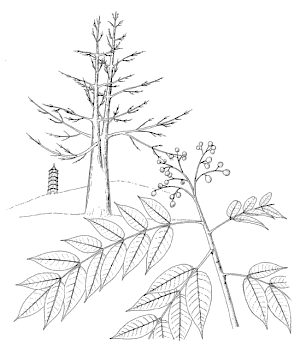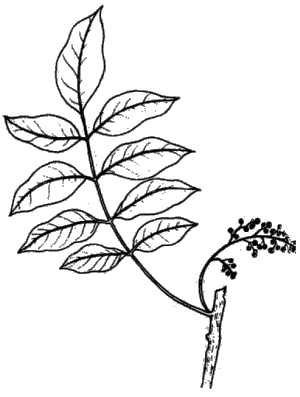Eastern Poison Oak
Toxicodendron quercifolium Michx.
Anacardiaceae family (Sumac family)

Occurrence: North America, particularly in the south-east of the USA in dry woodlands.
Description: Up to 1 m high shrub with threefold leaves. Single leaflets 3 to 7 cm long, lobed, slightly hairy underneath and brighter than on the top side. Flowering from May to June. Fruits hanging. See Poison Ivy.
Effects: See Toxicodendron species in general.
Measures: See Toxicodendron species in general.
Reference: U.S. Department of Health; Benezra; Roth; Peterson
Poison Ivy
Toxicodendron radicans L.
Anacardiaceae family (Sumac family)

Synonyms: Eastern Poison Ivy (en), Giftefeu (de)
Other scientific names: Rhus toxicodendron Linn., Rhus radicans Linn.
Occurrence: Throughout North America, particularly in the eastern and central parts of the USA. Frequently found in forests and on fields, in rocky canyons and on river banks. At altitudes below 1300 m.
Description: Crawling shrub up to 2 m heigh, sometimes climbing higher. Leaves greenish, sometimes shiny, long-stalked, 10 to 35 cm long and threefold. Middle leave on a longer stalk. Young leaves orange to brown with yellowish veins. Flowers in June, yellowish green, 5 mm. Fruits are hard berries in the shape of a peeled Orange, 5 to 7 mm in diameter, greenish-white or yellowish, from August to March. Young parts of the plant slightly hairy. The plant contains a latex which gets dark in a few minutes when exposed to air.
Effects: See Toxicodendron species in general.
Measures: See Toxicodendron species in general.
Reference: U.S. Department of Health; Benezra; Roth; Peterson
Japanese Laquer Tree
Toxicodendron vernicifluum Stokes.
Anacardiaceae family (Sumac family)

Synonyms: Varnish Tree (en), Lacksumach (de), Urushi (jp)
Other scientific names: Rhus verniciflua Stokes., Rhus vernicifera Dc.
Occurrence: Native of Japan, Central and western China. Also cultivated in other regions for the production of Japanese lacquer.
Description: 15 to 20 m tall tree with 7- to 13-fold leaves. Single leaflets are 10 to 20 cm long and 3 to 7 cm wide. Berries are straw-coloured, 10 mm in diameter. Appearance like Toxicodendron vernix. The milky latex turns black in a few minutes when exposed to air.
Effects: The sap acts skin-irritating chemically and is allergizing. The dried lacquer is skin-irritating only for very few people.
Measures: See Toxicodendron species in general.
Poison Sumac
Toxicodendron vernix L.
Anacardiaceae family (Sumac family)

Synonyms: Giftsumach (de)
Other scientific names: Rhus vernix L., Rhus venenata Dc.
Occurrence: North America, particularly in the east in swampy areas.
Description: Shrub or small tree up to 3 m, rarely up to 7 m. Twigs orange to brown, later becoming grey. Leaves up to 40 cm long and 7- to 13-fold. Single leaflets shorter than 10 cm. Inflorescences with fluffy hairs and longer than 10 cm. Berries white, hard, sperical, smooth, 5 mm in diameter, yellowish or grey in hanging clusters. (Harmless Sumac species, on the contrary, have red fruits).
Effects: See Toxicodendron species in general.
Measures: See Toxicodendron species in general.
Reference: U.S. Department of Health; Benezra; Roth; Peterson
Toxicodendron Species in General
Toxicodendron spp.
Anacardiaceae family (Sumac family)
Effects: Allergizing through urushiol in the resin of the plants. Through small injuries of the plant the resin can escape in low amounts from the leaf surface and from there get on the skin of a person who touches the leaf. Such small amounts can be already enough to induce an allergy. The allergen penetrates through the unhurt skin into the human body. However, the first contact remains mostly without any reaction. Subsequent contacts with a plant with any parts of the skin can induce rashes which appear right there and at the parts of the skin affected in earlier contacts. 24 to 48 hours after contact, itching, reddening, swelling, and wetting blisters use to appear. Against common opinion the liquid contained in the blisters is not an allergen and can transfer the rashes not to other people. However, this can happen by resin that remained on the skin.
The symptoms reach their climax approximately during the fifth day, then they heal without treatment in 1 to 2 weeks without leaving scars. However, secondary infections are possible if the blisters are not kept sterile. Abscesses or fever may occur then and scars can remain. If the poison gets into the eyes, severe inflammations and temporary or remaining cornea turbidity can follow. The allergy induced by the first contact usually lasts many years.
50% of the Americans react to slight contacts. Only 30% do not react at all. The poison is present in the plants also in winter, and also in dead and decaying plants. Smoke particles of burning parts of the plant spread the poison and can affect the skin and the respiratory tract. The allergen is spread easily, for example by shaking hands or via the fur of straying pets. The urushiol remains active outside the plant during at least 1 year and is not soluble in water. It is soluble in soap solution, though.
Measures: Thorough washing of the skin with water and soap as soon as possible after contact with the plant. If the skin is being washed within few hours this will likely prevent the reaction. Alcohol is unsuitable for cleaning because it accelerates the penetration of the poison into the skin. If no soap is available, the sap of Impatiens plants may also help. Rinsing the skin in flowing water is better than doing nothing at all. Rashes can be alleviated with corticosteroid ointment, while severe reaction needs medical attention. With very sensitive people it may be necessary to prevent allergic reactions with corticosteroids taken orally within 24 hours after contact. If one wants to remove Toxicodendron plants from a garden, they must be dug out with all roots.
Reference: U.S. Department of Health; Benezra; Roth; Peterson